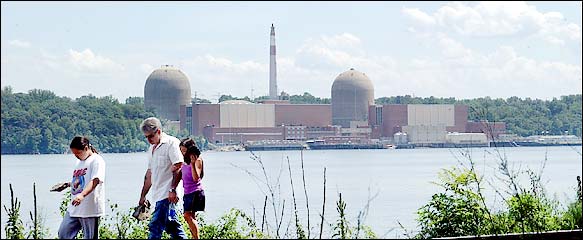There's Indian Point, and Counterpoints
 Richard L.
Harbus for The New York Times
The cooling towers at the Indian
Point nuclear power plant on the Hudson River in Westchester County remind some
nearby residents of possible safety
hazards. |
![]() f there was ever a moment when it seemed possible to force the
closing of the Indian Point nuclear power plant, it was after two planes flew
into the World Trade Center.
f there was ever a moment when it seemed possible to force the
closing of the Indian Point nuclear power plant, it was after two planes flew
into the World Trade Center.
The attack on New York City on Sept. 11, 2001, transformed a movement once dominated by a small band of antinuclear activists and environmentalists into the cause of suburban soccer moms and Little League dads. Alarmed that one of the planes carrying the hijackers had flown near Indian Point, about 35 miles north of Midtown Manhattan, and worried about how their families would get out of their densely populated suburban communities should disaster strike, many slapped "Close Indian Point" bumper stickers on their minivans and sport utility vehicles.
Yet nearly two years after the terrorist attack, the decades-old struggle to close Indian Point seems no nearer to its goal. The best evidence of this fact came last week, when the Federal Emergency Management Agency slammed shut the only window local communities had into the odd regulatory world that governs nuclear plants, endorsing an emergency evacuation plan that local and state officials said was seriously flawed.
For months, the plan was the focus of intense lobbying and activism, with many local officials refusing to certify it as an adequate blueprint for the complex task of getting the 300,000 people who live within 10 miles of the plant to safety in the event of an accident or terrorist attack.
But the Nuclear Regulatory Commission approved the plan within hours of the emergency management agency's finding. The move, which was met with near-universal dismay by many of those who live near the plant, is a fundamental shift in the battle over Indian Point.
"The policy questions surrounding this issue are now closed," said Richard Brodsky, a state assemblyman from Westchester County who wants the plant shut down. "We are now essentially in a political and a legal struggle. We can either go to the courts or change the politics of the situation. In my opinion, we need to do both."
Refusing to concede the regulatory commission's decision to approve the evacuation plan as a defeat, those who would close the plant argue that the emergency management agency's actions will energize the movement and open new legal and political avenues toward shutting the plant.
The emergency plan does not require Congressional approval. But those who want the plant to close say they plan to put more pressure on their representatives in Congress and on Gov. George E. Pataki to push FEMA and the regulatory commission to reconsider their decisions. They also plan to consider filing lawsuits to challenge the federal agencies in court.
"We never expected that this would be easy," said Alex Matthiessen, director of Riverkeeper, an environmental group at the center of the campaign to shut down the plant. "This is not a setback."
Much of the political effort will center on persuading the federal agencies to explain their decisions. Senator Hillary Rodham Clinton wrote last week to FEMA's director, Michael D. Brown, requesting documentation used in making the decision to approve the plan.
She also asked for the agency's support for Senate hearings about the plan, and asked for a full-scale planning exercise within six months, rather than in June 2004, to be evaluated by independent observers.
Representative Sue Kelly, whose Congressional district includes Indian Point and thousands of people who live near it, is calling for hearings to find out why the emergency management agency approved the plan despite the reservations of local officials and a report by James Lee Witt, the agency's former director and now a private consultant, who studied the plan for Mr. Pataki and issued a report calling it inadequate.
"If FEMA won't come in willingly" to answer questions about the decision, Ms. Kelly said, "I am going to ask that we subpoena them and put them under oath and make them testify."